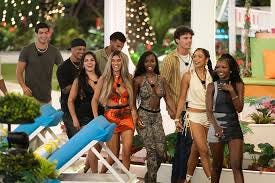Reality Tv is a Mirror
Love Island USA Season 7 Reveals About Emotions, Boundaries, and Being Seen
For as far back as I can remember, I have loved reality TV.
All genres. All eras. Just like the weather, I too have had seasons.
There were seasons I watched TV religiously.
There were seasons I was too busy to even glance at a screen.
And there were seasons that broke me so badly, I turned to reality TV to escape my own reality.
Television has saved me time and time again. It has broken, then repaired my heart. Restored and renewed my faith, only to disappoint and confirm my worst fears — and sometimes all of that happens in one episode.
There are moments I’ve seen on TV that mirrored my 19-to-23-year-old self. And those moments whispered back to me: you weren’t crazy. That really happened. And it was never okay.
Case in point: Amaya “Papaya” Espinal, the vibrant NYC Islander on Season 7 of Love Island USA. (An entire piece is needed just to unpack how chaotic and controversial this season is turning out to be.)
Amaya was first coupled with Ace Greene, the LA dancer and social media entrepreneur. But within 24 hours, they clashed after Amaya casually called him “babe.” What followed was a debate on boundaries: Was it okay for Ace to correct her so strongly? Was Amaya wrong to say it in the first place? The encounter left her shaken. What was supposed to be a soft landing turned into emotional instability — and that stayed with her.
She was soon recoupled with Austin, freshly removed from a love triangle with Chelley and Ace. But instead of something fresh, Amaya got coldness. Austin’s entire energy changed — his tone, his vibe, everything. She felt it instantly. And once again, she was stuck in a connection that didn’t value her.
Two men. No real match. Just vibes and letdowns.
But then came the kicker: Jeremiah’s elimination.
Despite clearly having a real connection with Andreina and even Huda, he was sent home. And fans weren’t having it. Social media lit up with outrage. Many speculated that Ace, Nic, and Taylor saw Jeremiah as a threat — not because he caused drama, but because he was emotionally intelligent, connected with the women genuinely, and had actual chemistry. That made him dangerous.
Meanwhile, Amaya’s future in the villa was put to a vote — by the very people who failed to pour into her.
And Huda — who had been confrontational, aggressive, and made others visibly uncomfortable — got a second chance. Why? Because Megan Thee Stallion came on an episode and reframed Huda’s narrative: she asked America to view her not as a villain but as a full human being who had been dehumanized.
And it worked. Huda was redeemed. Amaya was in the bottom. Hannah and Jeremiah were eliminated.
Even Ace himself admitted it didn’t make sense that the girls chose Hannah over Amaya — and yet he voted Jeremiah out? Make it make sense.
Reality TV as a Mirror
For all the critiques lobbed at reality TV, one thing’s true: people don’t just watch — they study it.
From a sociological perspective, shows like Love Island USA act as emotional laboratories. Viewers subconsciously (and sometimes actively) observe how people express feelings, handle conflict, draw boundaries, and perform gender roles — and those observations shape our own behavior.
Social Learning Theory in Action
According to Bandura’s Social Learning Theory, people learn behavior by observing others, especially in emotionally charged situations. Reality TV gives us a steady stream of this:
How do people handle rejection or embarrassment?
What happens when someone oversteps a boundary?
How do power dynamics shift in a group setting?
When Ace reacted negatively to Amaya calling him “babe,” it wasn’t just a throwaway moment. It was a case study in boundary-setting, emotional communication, and misunderstanding.
As a viewer, you’re invited to ask:
Was that an overreaction?
Was Amaya being disrespectful?
How would I handle that situation?
This internal processing helps people — especially younger viewers — develop emotional intelligence. It may even offer templates for how not to behave.
Emotional Regulation: Cringe as Curriculum
Watching someone spiral on national TV, pick the wrong partner, or lash out in frustration can be deeply uncomfortable. That discomfort is didactic. It teaches you how emotions escalate, how communication breaks down, and what it looks like to lose control.
Huda’s arc is a perfect example: her early aggressive confrontations alienated the group. She created emotional discomfort for others — and herself. But when America was asked to consider why she acted out, and Megan Thee Stallion reframed her behavior in terms of trauma and dehumanization, the collective response shifted.
This prompts important sociological questions:
What do we expect from women in conflict?
Who gets to show anger, and who gets punished for it?
What does "redemption" look like, and who gets offered that path?
Parasocial Reflection and Identity
Reality TV viewers often identify with contestants — especially those going through emotional upheaval. For some, Amaya’s pain reflected personal relationship patterns or past trauma. This creates a parasocial learning loop: we empathize, reflect, and evolve by seeing parts of ourselves on-screen.
It’s one of the few genres where emotion is raw, messy, and mostly unscripted — and that vulnerability, while entertaining, is also profoundly educational.






